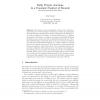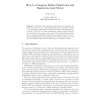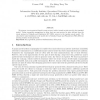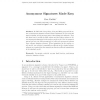CRYPTO
2001
Springer
14 years 11 months ago
2001
Springer
The OAEP encryption scheme was introduced by Bellare and Rogaway at Eurocrypt ’94. It converts any trapdoor permutation scheme into a public-key encryption scheme. OAEP is widel...
FC
2003
Springer
15 years 15 days ago
2003
Springer
Abstract. We present a new cryptographic auction protocol that prevents extraction of bid information despite any collusion of participants. This requirement is stronger than commo...
TYPES
2004
Springer
15 years 19 days ago
2004
Springer
Abstract. Most approaches to the formal analysis of cryptography protocols make the perfect cryptographic assumption, which entails for example that there is no way to obtain knowl...
CRYPTO
2004
Springer
15 years 21 days ago
2004
Springer
Ordinarily, RSA and Rabin ciphertexts and signatures are log N bits, where N is a composite modulus; here, we describe how to “compress” Rabin ciphertexts and signatures (among...
ESORICS
2005
Springer
15 years 25 days ago
2005
Springer
Abstract. Formal methods have been extensively applied to the certification of cryptographic protocols. However, most of these works make the perfect cryptography assumption, i.e....
CRYPTO
2005
Springer
15 years 25 days ago
2005
Springer
The Full-Domain Hash (FDH) signature scheme [3] forms one the most basic usages of random oracles. It works with a family F of trapdoor permutations (TDP), where the signature of m...
ACNS
2006
Springer
15 years 1 months ago
2006
Springer
We propose a new password-based 3-party protocol with a formal security proof in the standard model. Under reasonable assumptions we show that our new protocol is more efficient t...
PKC
2007
Springer
15 years 1 months ago
2007
Springer
Abstract. At PKC 2006, Yang, Wong, Deng and Wang proposed the notion of anonymous signature schemes where signatures do not reveal the signer’s identity, as long as some parts of...
CCS
2007
ACM
15 years 1 months ago
2007
ACM
In this work we re-visit the question of building cryptographic primitives that remain secure even when queried on inputs that depend on the secret key. This was investigated by B...
ACISP
2007
Springer
15 years 1 months ago
2007
Springer
Abstract. Digital signatures are often proven to be secure in the random oracle model while hash functions deviate more and more from this idealization. Liskov proposed to model a ...




